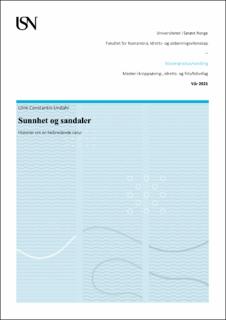| dc.description.abstract | Denne oppgaven ser på hvordan natur og elementer av natur blir forstått som sunt eller helbredende i tidsperiodene 1890-1910 og 2000-2020. Jeg vil undersøke hvordan argumentene som har preget de to tidsperiodene har påvirket sin samtids praksiser, ved å sammenligne dagens tale om «den sunne naturen» med tale og praksiser fra eldre tider. Jeg vil i denne oppgaven forsøke å vise at vår forståelse av naturen som sunn og helbredende ikke har oppstått i et vakuum; den sunne naturen har en historie, og denne historien former vår tids praksiser og forståelser. Oppgaven tar utgangspunkt i Norman Faircloughs og Michel Foucaults diskursanalyser. Kildegrunnlaget fra tidsperioden 1890-1910 består av tekster fra Sundhedsbladet og Tidsskrift for den Norske Lægeforening, og kildegrunnlaget fra tidsperioden 2000-2020 består av tekster hentet fra Tidsskrift for Den norske legeforening og Fjell og vidde.
I overgangen fra det 19. til det 20. århundre snakket man ikke om én enhetlig sunn natur slik vi gjør i dag, men om flere klima som fungerte på ulike måter. Høyfjellsklima, skogsklima og kystklima ble forstått som helbredende, og ved riktig dosering av en lege kunne disse klimatoterapiene helbrede somatiske sykdommer som tuberkulose og nevrasteni. Skolemedisinernes makt var utfordret av naturlegene, en lekfolkstradisjon med utspring i Tyskland. Naturlegene forsøkte i likhet med skolemedisinerne å kurere syke, men hadde et større fokus på å forebygge sykdommer gjennom å herde korpen; en naturlig, sterk kropp skulle være mindre mottagelig for sykdom.
I dag snakker vi ikke lenger om ulike klima med ulike kvaliteter. Naturen blir nå forstått som en homogen enhet, som i hovedsak helbreder psykiske sykdommer. Likevel skal kroppen fortsatt herdes i natur gjennom fysisk aktivitet. I motsetning til de gamle klimaene er denne naturen alltid sunn og helbredende, og som jeg vil argumentere for i denne oppgaven, er denne naturen mer romantisert i dag enn den var for 100 år siden. | |
| dc.description.abstract | This thesis explore how nature and elements of nature were understood as healthy and healing in the time periods 1890-1910 and 2000-2020. I will investigate how the different arguments that have characterized the two time periods has influenced their contemporary practices, by comparing todays speech of “a healthy nature” with speech and practices form an earlier period. I hope to prove that our conception of a healthy nature did not arise spontaneously; the restorative, healthy nature of today has a history, and this history influences today’s practices. This thesis draws on Norman Fairclough’s and Michel Foucault’s discourse analysis. The data form the first period are form The Journal of the Norwegian Medical Association and Sundhedsbladet, a popular health magazine, and the data from the second period is again form The Journal of the Norwegian Medical Association and Fjell og vidde, a magazine published by The Norwegian Trekking Association.
In the time period 1890-1910, one did not speak of one uniform or homogenous nature as we do today, but rather of different climates, that had distinct effects on the human body. Alpine and sub-alpine climates, along with forest and coastal climates were understood as healing, and with the guidance for a medical doctor, the climatotherapy could heal severe somatic diseases like tuberculosis and neurasthenia. The medical profession’s power was challenged by natural healers (Ger. Naturheilkundige), a tradition of lay people originated in Germany. The natural healers, like the medical doctors, would try to heal diseases, but also tried to harden and toughen their followers’ bodies. A natural, strong body were believed to be more resistant towards diseases.
Today, we no longer speak of different climates with distinct qualities and effects. Nature is now seen as a homogenous phenomenon, which primarily has an effect on the human psychology. Yet, we are still encouraged to harden our bodies in nature, this time by medical doctors. Contrary to the old climates, todays nature is always healthy and healing, and as I will argue in this thesis, this nature is more romanticized than it was 100 years ago. | |
